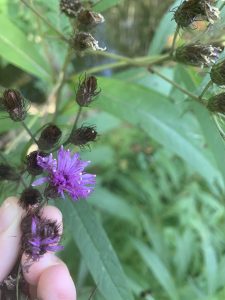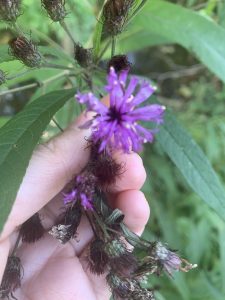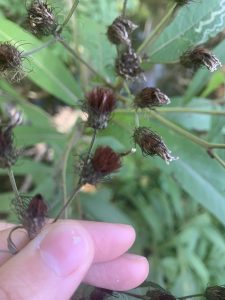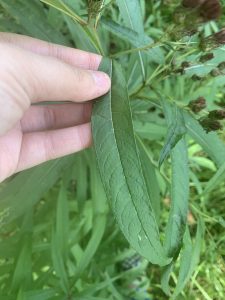
The purple wildflowers that are still alive in contrast with those which are dead.
On Saturday, October 3rd, I traveled to my sit spot for the third time; this time I set out with purpose and the intention of observing and identifying an unknown organism. During each of my previous sit spot excursions I have observed and chosen to follow the flowers that sit directly south of me, commonly referring to them by the vague name “purple wildflowers”; thus, I believed that identifying this species would have the greatest relevance in relation to my sit spot investigation, as I would finally be able to distinguish the plant I have been continuously observing. Furthermore, although I have noticed numerous individual “purple wildflower” plants that border the grassy area of the creek, I chose to observe and identify the flowering plant that sits directly south of my sit spot. I chose this particular organism because of its close proximity to my sit spot, as it is legitimately only a few feet away from where I situate myself when I record my observations.
After I made the decision to observe (and later attempt to identify) the unknown purple wildflowers, I stood up and moved closer to the

The petals of the Ironweed plant are tubular in structure.
organism in order to make the most accurate observations. I primarily focused on my sense of sight, but when I initially looked upon the flowering plant I had trouble deciding what to describe first. I began by looking at the petals of each flower; for the flowers that were fortunate enough to have survived this far into the season, their petals appeared to be a dark purple color and could be characterized as a tubular,
three-dimensional structure. The color of the dying flowers contrasted with this vibrant purple, as they were a brownish/ black color. The tubular shape was somewhat still present in the dead and dying flowers, but the petals looked recessed and condensed. The buds from which the petals sprouted were a dark purple/ black color, and each bud seemed to be covered in some

The dead flower petals are a brownish/ black color.
type of ‘woody exterior’ that possessed a diamond-shaped pattern. Furthermore, each flower can also be observed in a group, usually compiled of four to seven flowers; one flower is typically centered while the others surround it. Finally, I observed the leaves and stems of the flowering plant. The leaves were a vibrant green color, while their petiole

The leaves are green in color and possess a diamond shape, as well as a white petiole.
was a contrasting white, and the stems were a greenish-brown. The leaves were also thin and long and possessed somewhat of a diamond shape. After I had finished my observations pertaining to my sense of sight, I turned to use my somatosensory system. The petals of both the living and dead flowers were soft to the touch, which contrasted with my notion that the dying petals would be hard and crunchy (like the leaves that fall from a tree). The buds of each flower were rock hard (which made me ponder their chemical composition), and the leaves felt smooth but sticky (which made me then wonder if they were secreting some sort of sticky substance).
In order to identify my organism, I did what most technologically inclined teenagers would do, and I used the Internet (specifically Google). I legitimately typed “purple wildflowers Roanoke” into the search bar, and the search yielded a website that almost immediately identified the species of the flower I was attempting to identify. Thus, the process of finding the species of my organism was more fun than challenging; it didn’t require hours of searching, but rather a few minutes. It was exciting finding out the species of the organism that I had been observing for a few weeks prior. Overall, the experience of observing and identifying an unknown organism was enjoyable and something that I have wanted to do previously but didn’t want to necessarily spend the time or energy doing. However, the observations of the organism did seem quite repetitive, as I have previously been observing the wildflowers in the weeks prior to this assignment.
Ironweed (Vernonia noveboracensis) is a tall flower that blooms in the late summer months (particularly from August to September) and grows in Virginia and other locations in the eastern and southeastern United States (“Ironweed”, 2015). This plant typically grows in these locations because it flourishes in areas of high sunlight, moisture, and fertility as well as acidic soils; however, this flowering plant does have the ability to grow in locations devoid of these factors. The ironweed plant grows to heights of approximately five to eight feet, and it is a perennial plant which means it lives for more than two years. The Ironweed plant receives its namesake from the following factors: its petals turn a rust color with the changing seasons and its thick, tough stems mimic the strength of iron (“Ironweed”, 2015).
The flowers of the Ironweed plant are typically a deep purple or lavender color and their shape is that of a tubular disc (approximately 3 to 4 inches wide); furthermore, these flowers grow in a cluster formation, in which several flowers are closely gathered together. The leaves of the Ironweed plant are deciduous, or shredded annually, and alternately arranged on the stems (Vernonia Noveboracensis, 2017); furthermore, these leaves are green in color and have a lanceolate, or oval shape. The leaves also have a “simple” structure, which means that the leaves are undivided (have no leaf division).
The flowers of the Ironweed plant generally attract butterflies and have great importance to bees, as they attract large quantities of pollinators (Vernonia Noveboracensis, n.d.). Furthermore, different species of birds consume the seeds of the flowers and the nectar which they produce (Taylor, n.d.). Several other species of organisms also use the Ironweed plant as a food source, such as caterpillars and moths (Kulhanek, 2016). To other species, the bitter taste of the Ironweed plant serves as a natural deterrent; this is why it is often considered to be a weed, as livestock will not typically consume it.
References Cited
Ironweed. (2015). Virginia Wildflowers. Retrieved from
https://virginiawildflowers.org/2015/08/08/ironweed/.
Kulhanek, A. (2016). Perennial of the Week: Ironweed. Retrieved from
https://bygl.osu.edu/node/575.
Taylor, D. (n.d.). Plant of the Week: Giant Ironweed. Retrieved from
https://www.fs.fed.us/wildflowers/plant-of-the-week/vernonia_gigantea.shtml
Vernonia Noveboracensis. (2017). Lady Bird Johnson Wildflower Center. Retrieved from
https://www.wildflower.org/plants/result.php?id_plant=VENO.
Vernonia Noveboracensis. (n.d.). North Carolina Extension Gardener Plant Toolbox. Retrieved from https://plants.ces.ncsu.edu/plants/vernonia-noveboracensis/.

Thanks for doing these flowers! I have these at my sit-spot as well and was curious about them. You give a lot of details about the flowers and now I can add the names to my journal as I write about my sit-spots in the future! They are beautiful flowers. It is very interesting that livestock will not eat it, but insects will. Do you happen to know why that is?